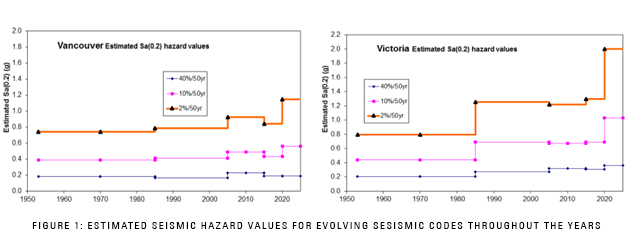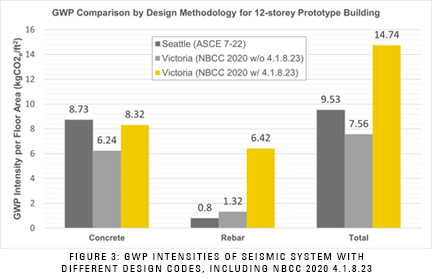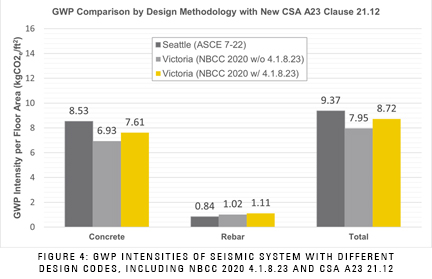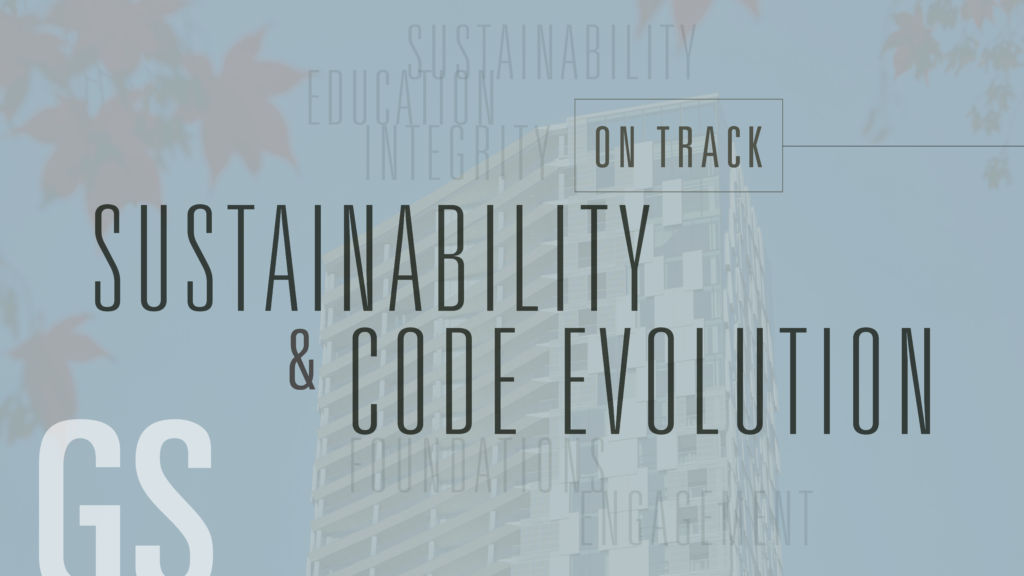
Sustainable Building Design and its Intersection with the Building Code and Performance Based Design
Seismic codes are ever evolving and generally ever increasing. The seismic clauses of NBCC 2020, which take effect in March 2025, respond to increased earthquake risks and enhances building performance, but they will also have an immediate impact on cost and embodied carbon. In this month’s edition, we take a closer look at this tradeoff with a focus on high-importance and post-disaster structures.
Many of the new provisions introduced in NBCC2020 address the evolving skyline and increasingly complex architecture, such as projects like Vancouver House, Alberni by Kengo Kuma and 1515 Alberni; our team used non-linear analysis to understand the seismic behavior of these buildings, but the code is now responding to these designs and offering more prescriptive approaches. Some of these revisions respond to newly discovered fault lines or geological conditions, which explains the steep jump in accelerations in 2020 for Victoria in Figure 1, and others respond to new seismic research and testing.
Many of the new provisions will unequivocally improve building performance in a seismic event, but we recognize that these increases in performance need to be evaluated wholistically and must also consider immediate costs to the owner and the planet. As one of the leading Structural Engineering firms in North America, we were given the opportunity to comment on new code provisions and offer our insight.
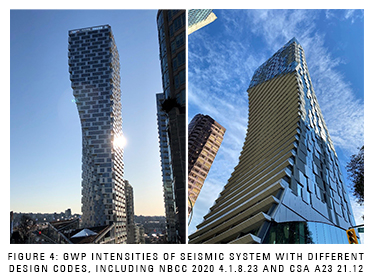 We are especially proud of our work in mitigating the effects of a new 2020 NBCC clause, 4.1.8.23, specifically aimed at the seismic design of our critical buildings such as hospitals, police facilities and schools (high-importance and post-disaster buildings). When it was introduced, Dr. Ehsan Dezhdar, who leads our innovative Performance Based Design team, recognized the newly included clause was adding considerable costs to our critical infrastructure, often, without significantly increasing performance.
We are especially proud of our work in mitigating the effects of a new 2020 NBCC clause, 4.1.8.23, specifically aimed at the seismic design of our critical buildings such as hospitals, police facilities and schools (high-importance and post-disaster buildings). When it was introduced, Dr. Ehsan Dezhdar, who leads our innovative Performance Based Design team, recognized the newly included clause was adding considerable costs to our critical infrastructure, often, without significantly increasing performance.
Our team conducted two studies and published two papers aimed at understanding this trade-off between increased performance and other associated costs.
We studied a prototypical 12-storey building and designed it with and without the adoption of the new clause, and then analyzed it using more detailed methods to understand its behaviour. We also compared these results to similar designs in the American code and New Zealand code.
The study found that introduction of the clause resulted in a 33% increase in wall thicknesses, 400% increase in the amount of longitudinal reinforcement in boundary elements, and 100% increase in the magnitude of overturning bending moment demand for the foundation design. This not only resulted in substantial material and cost increases, but it also directly translated to a considerable intensification in embodied carbon as shown in the graph below. Moreover, using performance-based non-linear analysis, our team found that the prototype building performed only marginally better with the newly introduced 2020 NBCC clause.
Dr. Dezhdar and our team presented their paper to the standing code committee for NBCC and CSA A23; in response, the CSA A23 committee introduced a new clause (Clause 21.12) in the concrete design code, CSA, which allows Design Engineers to evaluate the performance of post-disaster and high-importance building based on the principles of performance-based design.
With the introduction of the new CSA A23 clause 21.12, the material quantities of the lateral system steeply dropped. And with that, the embodied carbon intensity of the lateral system was greatly reduced. As shown in Figure 4 below, for the Victoria design with NBCC 2020 clause 4.1.8.23, the GWP intensity drastically reduced by 40% from 14.74 kgCO2e/ft2 to 8.72 kgCO2e/ft2, when accounting for the new CSA clause.
This is just one example, which illustrates the compromise between the reduced seismic risk in the long-term and the material and embodied carbon costs in the short term. In this instance, the answer was obvious, and the CSA concrete code was remedied to address this; but in most instances, it is much more nuanced.
As buildings become increasingly complex and potentially outgrow prescriptive code approaches, we may want to consider the benefits of more advanced methods of analysis to reduce conservatism and improve performance. In forthcoming editions, we will look at how we might be able to leverage more advanced computational power, knowledge, and analysis to increase building performance and sustainable building design.
Written by Rachelle Habchi, Director of Sustainability and Dr. Ehsan Dezhdar, Senior Associate
Glotman Simpson’s On Track series delves into factors we can explore to reduce the environmental impact of building structures. The need to accelerate climate action in the form of innovative solutions that minimize both operational and embodied carbon is imperative and represents a critical part of a low-carbon future.

